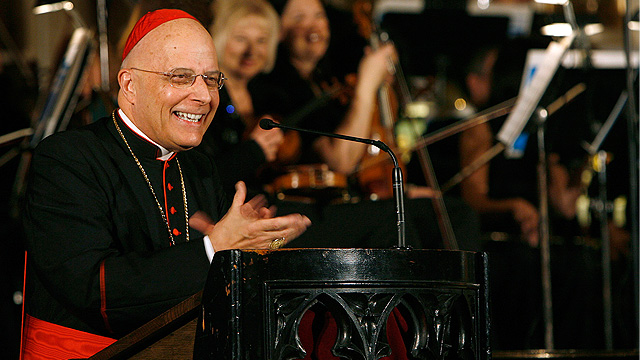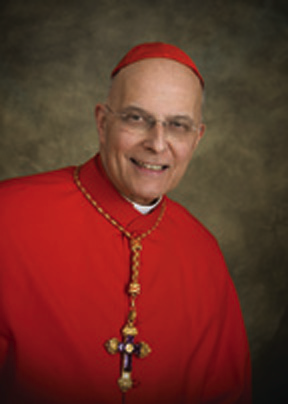

A Lion of the American Church: Thoughts on the Passing of Cardinal George
Salt + Light Media
Monday, April 20, 2015

By Very Rev. Robert Barron
Father Robert Barron is the founder of the global ministry,Word on Fire, and the Rector/President of Mundelein Seminary. He is the creator of the award winning documentary series, "Catholicism" and "Catholicism:The New Evangelization.
Cardinal Francis George, who died last week at the age of 78, was obviously a man of enormous accomplishment and influence. He was a Cardinal of the Roman Church, a past president of the United States Conference of Catholic Bishops, the Archbishop of one of the largest and most complicated archdioceses in the world, and the intellectual leader of the American Church. A number of American bishops have told me that when Cardinal George spoke at the Bishops’ meetings, the entire room would fall silent and everyone would listen.
But to understand this great man, I think we have to go back in imagination to when he was a kid from St. Pascal’s parish on the Northwest side of Chicago, who liked to ride his bike and run around with his friends and who was an accomplished pianist and painter as well. At the age of thirteen, that young man was stricken with polio, a disease which nearly killed him and left him severely disabled. Running, bike riding, painting, and piano playing were forever behind him. I’m sure he was tempted to give up and withdraw into himself, but young Francis George, despite his handicap, pushed ahead with single-minded determination. The deepest longing of his heart was to become a priest, and this led him to apply to Quigley Seminary. Convinced that this boy with crutches and a brace couldn’t make the difficult commute every day or keep up with the demands of the school, the officials at Quigley turned him away. Undeterred, he applied to join the Oblates of Mary Immaculate, a missionary congregation. Recognizing his enormous promise and inner strength, they took him in.
I bring us back to this moment of the Cardinal’s life, for it sheds light on two essential features of his personality. First, he was a man who never gave up. I had the privilege of living with Cardinal George for six years and thus I was able to see his life close-up. He had an absolutely punishing schedule, which had him going morning, noon, and night, practically every day of the week: administrative meetings, private conversations, banquets, liturgies, social functions, public speeches, etc. Never once, in all the years I lived with him, did I ever hear Cardinal George complain about what he was obliged to do. He simply went ahead, not grimly but with a sense of purpose. When he first spoke to the priests of the Archdiocese as our Archbishop, he said, “Never feel sorry for yourself!” That piece of advice came, you could tell, from the gut.
Second, his identity as an Oblate of Mary Immaculate deeply marked him as a man of mission. The OMI’s are a missionary congregation, whose work takes them all over the world, from Africa and Asia to Latin America, the Yukon, and Alaska—not to mention Texas and Belleville, Illinois. When he was a novice and young OMI seminarian in Belleville, Francis George heard the stories of missioners from the far reaches of the globe, and he imbibed their adventurous spirit. As the vicar general of his order, he undertook travels to six continents, dozens of countries, visiting with thousands of OMI evangelist priests. I was continually amazed at his detailed knowledge of the politics, culture, and history of almost any country or region you could name. It was born of lots of direct experience.
This missionary consciousness is precisely what informed the intellectual and pastoral project that was closest to his heart, namely, the evangelization of the contemporary culture. In this, he showed himself a disciple of his great mentor Karol Wojtyla, Pope John Paul II. What Cardinal George brought rather uniquely to the table in this regard was a particularly clear grasp of the philosophical underpinnings of the Western and especially American cultural matrix. Cardinal George often signaled his impatience with the term “counter-cultural” in regard to the Church’s attitude vis-à-vis the ambient culture. His concern is that this can suggest a simple animosity, whereas the successful evangelist must love the culture he is endeavoring to address. But he saw a deeper problem as well, namely, that, strictly speaking, it is impossible to be thoroughly counter-cultural, since such an attitude would set one, finally, against oneself. It would be a bit like a fish adamantly insisting that he swims athwart the ocean. Therefore, the one who would proclaim the Gospel in the contemporary American setting must appreciate that the American culture is sown liberally with semina verbi (seeds of the Word).
The first of these, in Cardinal George’s judgment, is the modern sense of freedom and its accompanying rights. Following the prompts of Immanuel Kant, modern political theorists have held that all human beings possess a dignity which dictates that they should never be treated merely as a means but always as an end. It is interesting to note that the young Karol Wojtyla, in his early work in philosophical ethics, put a great premium on this second form of the Kantian categorical imperative. What Cardinal George has helped us see is that, at its best, this modern stress is grounded in a fundamentally theological understanding of the human person as a creature of God. Were the human being construed simply as an accidental product of the evolutionary process, then he would not enjoy the irreducible dignity that is assumed by Kant. Indeed, Kant’s contemporary Thomas Jefferson rather clearly indicated that his understanding of human rights was conditioned by the Christian theological heritage when he specified that those rights are granted, not by the state, but by the Creator.
The Kantian-Jeffersonian philosophical anthropology must be distinguished, Cardinal George insisted, from Thomas Hobbes' account. On the Hobbesian reading, rights are grounded, not so much in divine intentionality, but in the unavoidability of desire. Hobbes opined—and John Locke essentially followed him—that we have a right to those things that we cannot not desire. For Hobbes this meant the sustenance of biological life and the avoidance of violent death, whereas for Locke, it was somewhat broadened to mean life, liberty, and property. The problem is that Hobbes’s interpretation is thoroughly non-theological and his consequent understanding of the purpose of government is non-teleological, purely protective rather than directive. Government exists, not for the achievement of the common good, but for the mutual protection of the citizens. That the Hobbesian strain found its way into the American political imagination is clear from Jefferson’s refusal to characterize the nature of happiness, even as he insisted on the universal right to pursue it. In a word, therefore, the Church can and must affirm, at least in its basic form, the Kantian understanding of freedom and rights, even as it can and must stand against the purely secularist Hobbesian notion.
Cardinal George knew that the prime spokesperson for this deft act of affirmation and negation was Pope John Paul II, who emerged, in the late twentieth-century, as the most articulate and vociferous defender of human rights on the world stage. The Cardinal drew attention to a speech that the Pope made in Philadelphia in 1979. John Paul sang the praises of our Declaration of Independence, with its stress on God-given rights, but he filled in the theological background by referencing the Genesis account of our creation in the image and likeness of God. Pressing well past any sort of Hobbesian secularism and utilitarianism, the Pope insisted that Jefferson’s ideal should inspire Americans to build a society that is marked by its care for the weakest and most vulnerable, especially the aged and the unborn.
The second major feature of modernity that Cardinal George identified is an extreme valorization of the physical sciences, or in his own words, “the imposing of scientific method as the point of contact between human beings and the world and society into which they are born.” The founders of modernity appreciated the sciences not only for their descriptive and predictive powers, but also for their liberating potential. Bacon, Descartes, Leibniz, Newton, Kant, and many others, held that the mastery over nature provided by burgeoning physics, chemistry, medicine, etc. would free the human race from its age-old captivity to sickness and the strictures of time and space. But what this led to—and I see it practically every day in my evangelical work—was the development of a “scientism” which, as a matter of ideological conviction, excludes non-scientific or extra-scientific ways of knowing, including and especially religious ways. The scientistic attitude has also obscured the undeniably theological foundations for the scientific enterprise, namely the assumptions that the world is not God (and hence can be analyzed) and that the world is stamped, in every detail, by intelligibility. Both of these assumptions are predicated upon the doctrine of creation, which the founders of modern science took in, along with their astronomy, mathematics, and physics, at church-sponsored universities. In the measure that the sciences flow from and rest upon the properly theological presumptions that non-divine universe is well-ordered and intelligible, Catholic theology can involve itself in a very fruitful dialogue with them; but in the measure that scientism comes to hold sway, the Church must resist.
One of Cardinal George’s most memorable remarks is that liberal Catholicism is an exhausted project. It is important that we parse his words here carefully. By “liberal Catholicism” he means an approach to the Catholic faith that takes seriously the positive achievements of the modern culture. In this sense, Lacordaire, Lord Acton, Lamennais, von Dollinger, and Newman were all liberal Catholics—and their successors would include De Lubac, Rahner, Guardini, Ratzinger, and Congar. One of the permanent achievements of the liberal Catholic project, in Cardinal George’s judgment, is “restoring to the center of the Church’s consciousness the Gospel’s assertion that Christ has set us free, but also for the insight and analysis that enabled the Church herself to break free of the conservative social structures in which she had become imprisoned.” In the 1950’s Hans Urs von Balthasar called, in a similar vein, for a “razing of the bastions,” behind which the church had been crouching, in order to let out the life that she had preserved. And this is very much in line with Vatican II’s limited accommodation to modernity in service of the evangelical mission. Liberal Catholicism also took into account the second great achievement of modernity, stressing that certain doctrinal formulations and Biblical interpretations had to be reassessed in light of the findings of modern science. One thinks in this context of the vociferous interventions, made by a number of bishops on the Council floor at Vatican II, concerning certain naïvely literalistic readings of the Old Testament.
All of this assimilation of the best of the modern represents the permanent achievement of Catholic liberalism, and this is why Cardinal George never argued that liberalism is simply a failed or useless project. He said it was anexhausted project, parasitical on a substance that no longer exists. What are the signs of exhaustion? The Cardinal explains that the liberal project has gone off the rails inasmuch as it “seems to interpret the Council as a mandate to change whatever in the Church clashes with modern society,” as though, in the words of the notorious slogan from the 1960’s, “the world sets the agenda for the Church.” If the Church only provides vaguely religious motivation for the mission and work of the secular society, then the Church has lost its soul, devolving into a cheerleader for modernity. The other principal sign of the exhaustion of the liberal project is its hyper-stress on freedom as self-assertion and self-definition. In Cardinal George’s words: “the cultural fault line lies in a willingness to sacrifice even the Gospel truth in order to safeguard personal freedom construed as choice.” We might suggest that another shadow side of Catholic liberalism is a tendency to accept the scientific vision of reality as so normative that the properly supernatural is called into question. We see this both in a reduction of religion to ethics and the building of the kingdom on earth, as well as in extreme forms of historical critical biblical interpretation that rule out the supernatural as a matter of principle.
What is too often overlooked—especially in liberal circles—is that Cardinal George was just as impatient with certain forms of conservative Catholicism. Correctly perceiving that authentic Catholicism clashes with key elements of modern culture, some conservatives instinctively reached back to earlier cultural instantiations of Catholicism and absolutized them. They failed thereby to realize that robust Catholicism is, in Cardinal George’s words, “radical in its critique of any society,” be it second-century Rome, eighteenth-century France, or the America of the 1950’s. What he proposed, finally, was neither liberal nor conservative Catholicism, but “simply Catholicism,” by which he meant the faith in its fullness, mediated through the successors of the Apostles.
At the heart of this Catholicism in full is relationality. Cardinal George has often pointed out that Catholic ontology is inescapably relational, since it is grounded in the Creator God who is, himself, a communion of subsistent relations. More to it, the Creator, making the universe, ex nihilo, does not stand over and against his creatures in a standard “being-to-being” rapport; rather, his creative act here and now constitutes the to-be of creatures, so that every finite thing is a relation to God. Aquinas expressed this when he said that creation is “a kind of relation to the Creator, with freshness of being.” This metaphysics of relationality stands in sharp distinction to the typically modern and nominalist ontology of individual things, which gave rise to the Hobbesian and Lockean political philosophy sketched above, whereby social relations are not natural but rather artificial and contractual. Since grace rests upon and elevates nature, we should not be surprised that the Church is marked by an even more radical relationality. Through the power of Christ, who is the Incarnation of the subsistent relation of the Trinity, creation is given the opportunity of participating in the divine life. This participation, made possible through grace, is far more intense than the relationship that ordinarily obtains between God and creatures and among creatures themselves, and Catholic ecclesiology expresses that intensity through a whole set of images: bride, body, mother, temple, etc.
In Cardinal George’s striking language: “the Church is aware of herself as vital, and so calls herself a body. The Church is aware of herself as personal, and so calls herself a bride who surrenders to Christ. The Church is aware of herself as a subject, as an active, abiding presence that mediates a believer’s experience, and so calls herself mother. The Church is aware of herself as integrated, and so describes herself as a temple of the Holy Spirit.” Notice please the words being used here: vital, personal, present, surrendering, mother, integrated. They all speak of participation, interconnection, relationship, what Cardinal George calls esse per (being through). This is the living organism of the Church which relates in a complex way to the culture, assimilating and elevating what it can and resisting what it must. This is simply Catholicism.
Cardinal George was a spiritual father to me. In his determination, his pastoral devotion, his deep intelligence, his kindness of heart, he mediated the Holy Spirit. For this I will always be personally grateful to him. I believe that the entire Church, too, owes him a debt of gratitude for reminding us who we are and what our mission is.
Please join us in prayer:
January 16, 1937 – April 17,Prayer for Francis Cardinal GeorgeO God of consolation, our hearts are heavy as we acknowledge our great sense of loss. We look to you for comfort and solace at the passing of your servant, Francis George. Welcome him into the warmth of your embrace and renew in us the consolation and hope of eternal life with you. Even in times of doubt, we know that your care reaches into the depths of our hearts. May the legacy of Cardinal George continue to inspire us to be a holy people of love and compassion. We ask this in the name of the One who came to destroy sin and death, your merciful Son, Jesus Christ, who is Lord for ever and ever. Amen.
Related Articles:
>>














